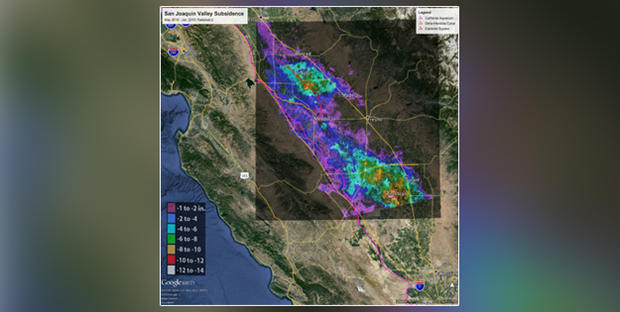NASA Report Finds Excessive Groundwater Pumping May Be Sinking California
LOS ANGELES (CBSLA.com/AP) — Some areas in California's Central Valley are sinking nearly two inches every month due to massive amounts of groundwater are pumped during the historic drought, researchers announced Wednesday.
A new report (PDF) from scientists at Jet Propulsion Laboratory and Caltech shows land near the city of Corcoran - roughly 60 miles northwest of Bakersfield - sank 13 inches in eight months, while part of the California Aqueduct sank eight inches in four months last year.
Sinking land has occurred for decades in California because of excessive groundwater pumping during drought conditions, but the new data shows it is happening faster, the Associated Press reported.
Long-term subsidence has already destroyed thousands of public and private groundwater well casings in the San Joaquin Valley. Over time, subsidence can permanently reduce the underground aquifer's water storage capacity.
Jeanine Jones of the California Department of Water Resources told KNX 1070 NEWSRADIO conservation measures enacted last year by Governor Jerry Brown are expected to help mitigate at least some impact from increased groundwater extraction.
"[The goal] is to, at the local level depending on local priorities, is control extractions, manage the construction of new wells, manage how new lands may be converted to agricultural production," said Jones.
But according to Mike Wade, executive director of the California Farm Water Coalition, environmental regulators have to re-evaluate their policies.
With some water wells now as deep as 2,500 feet, Wade says the only way to stop going so deep is for regulators to allocate more water above ground.
"The subsidence that we're seeing doesn't have to happen," Wade said. "It's primarily being caused by a lack of...surface water that we used to have access to that has been lost over the last seven, eight years or more."
As part of an ongoing effort to respond to the effects of the drought, a task force is working with communities to develop short-term and long-term recommendations to reduce the rate of sinking and address risks to infrastructure.
The Department of Water Resources is also launching a $10 million program to help counties with stressed groundwater basins to develop or strengthen local ordinances and conservation plans.
Last August, state officials took steps to regulate groundwater supply for the first time, as the worst drought in a generation pushed state leaders to overhaul the state's longstanding "pump-as-you-please" policy.
(TM and © Copyright 2015 CBS Local Media, a division of CBS Radio Inc. and its relevant subsidiaries. CBS RADIO and EYE Logo TM and Copyright 2015 CBS Broadcasting Inc. Used under license. All Rights Reserved. This material may not be published, broadcast, rewritten, or redistributed. The Associated Press contributed to this report.)




